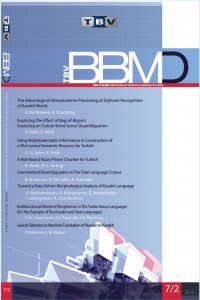Öz
This article presents a method of resolving lexical ambiguity of words in an automatic text processing for different groups of natural languages that have not marked corpus. The proposed method is based on creating context vectors by which held the semantic analysis of the text. This method has been successfully applied in the machine translation from Russian into Kazakh. The practical results presented.
Kaynakça
- Word Sense Disambiguation: Algorithms and Applications (Text, Speech and Language Technology), Ed. by AGIRRE E., EDMONDS P. G..— 1 edition.— Springer, 2007.—November
- YAROWSKY D., One sense per collocation // HLT ’93: Proceedings of the workshop on Human Language Technology.— Morristown, NJ, USA: Association for Computational Linguistics, 1993.— Pp. 266–271.
- TURDAKOV D., Recommender System Based on User-generated Content // Proceedings of the SYRCODIS 2007 Colloquium on Databases and Information Systems.— 2007.
- GALE W. A., CHURCH K. W., YAROWSKY D., A method for disambiguating word senses in a large corpus. // Computers and the Humanitzes.— Vol. 26.— 1993.— Pp. 415–439
- GALE W. A., CHURCH K. W., YAROWSKY D. One sense per discourse // HLT ’91: Proceedings of the workshop on Speech and Natural Language.— Morristown, NJ, USA: Association for Computational Linguistics, 1992.— Pp. 233–237
- RICHENS R. H.. Interlingual machine translation // Computer Journal.— Vol. 3.— 1958.— Pp. 144–147.
- JURAFSKY D., MARTIN J. M., Speech and Language Processing // second edition, Pearson Prentice Hall, New Jersey pp.640644.
- TUKEYEV U.A. , RAKHIMOVA D.R. et al., Development of morphological analysis and synthesis for machine translation from Russian into Kazakh using multivalued mapping tables. Computer processing of Turkic languages. First International Conference: Proceedings / Astana L.N.Gumilev ENU Publishing House, 2013, 182-191.(in Kazakh)
Öz
Kaynakça
- Word Sense Disambiguation: Algorithms and Applications (Text, Speech and Language Technology), Ed. by AGIRRE E., EDMONDS P. G..— 1 edition.— Springer, 2007.—November
- YAROWSKY D., One sense per collocation // HLT ’93: Proceedings of the workshop on Human Language Technology.— Morristown, NJ, USA: Association for Computational Linguistics, 1993.— Pp. 266–271.
- TURDAKOV D., Recommender System Based on User-generated Content // Proceedings of the SYRCODIS 2007 Colloquium on Databases and Information Systems.— 2007.
- GALE W. A., CHURCH K. W., YAROWSKY D., A method for disambiguating word senses in a large corpus. // Computers and the Humanitzes.— Vol. 26.— 1993.— Pp. 415–439
- GALE W. A., CHURCH K. W., YAROWSKY D. One sense per discourse // HLT ’91: Proceedings of the workshop on Speech and Natural Language.— Morristown, NJ, USA: Association for Computational Linguistics, 1992.— Pp. 233–237
- RICHENS R. H.. Interlingual machine translation // Computer Journal.— Vol. 3.— 1958.— Pp. 144–147.
- JURAFSKY D., MARTIN J. M., Speech and Language Processing // second edition, Pearson Prentice Hall, New Jersey pp.640644.
- TUKEYEV U.A. , RAKHIMOVA D.R. et al., Development of morphological analysis and synthesis for machine translation from Russian into Kazakh using multivalued mapping tables. Computer processing of Turkic languages. First International Conference: Proceedings / Astana L.N.Gumilev ENU Publishing House, 2013, 182-191.(in Kazakh)
Ayrıntılar
| Diğer ID | JA37MZ93ZN |
|---|---|
| Bölüm | Makaleler(Araştırma) |
| Yazarlar | |
| Yayımlanma Tarihi | 21 Aralık 2014 |
| Yayımlandığı Sayı | Yıl 2014 Cilt: 7 Sayı: 2 |
Kaynak Göster
https://i.creativecommons.org/l/by-nc/4.0Makale Kabulü | |
Çevrimiçi makale yüklemesi yapmak için kullanıcı kayıt/girişini kullanınız. Dergiye gönderilen makalelerin kabul süreci şu aşamalardan oluşmaktadır: 1. Gönderilen her makale ilk aşamada en az iki hakeme gönderilmektedir. 2. Hakem ataması, dergi editörleri tarafından yapılmaktadır. Derginin hakem havuzunda yaklaşık 200 hakem bulunmaktadır ve bu hakemler ilgi alanlarına göre sınıflandırılmıştır. Her hakeme ilgilendiği konuda makale gönderilmektedir. Hakem seçimi menfaat çatışmasına neden olmayacak biçimde yapılmaktadır. 3. Hakemlere gönderilen makalelerde yazar adları kapatılmaktadır. 4. Hakemlere bir makalenin nasıl değerlendirileceği açıklanmaktadır ve aşağıda görülen değerlendirme formunu doldurmaları istenmektedir. 5. İki hakemin olumlu görüş bildirdiği makaleler editörler tarafından benzerlik incelemesinden geçirilir. Makalelerdeki benzerliğin %25’ten küçük olması beklenir. 6. Tüm aşamaları geçmiş olan bir bildiri dil ve sunuş açısından editör tarafından incelenir ve gerekli düzeltme ve iyileştirmeler yapılır. Gerekirse yazarlara durum bildirilir.
|



